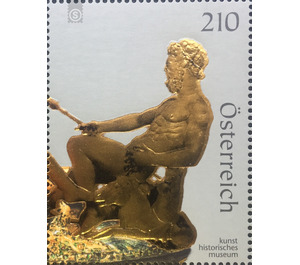Saliera - Austria / II. Republic of Austria 2009 - 210 Euro Cent
Theme: Art & Culture
| Country | Austria / II. Republic of Austria |
| Issue Date | 2009 |
| Face Value | 210.00 |
| Edition Issued | 400,000 |
| Printing Type | offset |
| Stamp Type | Commemorative |
| Item Type | Stamp |
| Chronological Issue Number | 2124 |
| Chronological Chapter | OOS-OE2 |
| SID | 260780 |
| In 21 Wishlists | |
The Saliera is the only surviving goldsmith's work of the Florentine sculptor, medalist and goldsmith Benvenuto Cellini (1500-1571). The salt (Italian "saliera") of gold is partially enamelled and stands on an ebony base, it is made in the style of the late Renaissance. The commission was created in the period between 1540 and 1543 while the goldsmith was in Paris. King Francis I of France had the salt cave made, which was later donated by Archduke Ferdinand II of Tyrol and thus came into the possession of the Habsburgs. Cellini's masterpiece shows an allegorical depiction of planet Earth. The figures were made of gold plate. In his self-written biography, which was later translated and edited by Johann Wolfgang von Goethe, the artist described the work as follows: "... to show how the sea connects to the earth, I made two figures, a good palm They sat with their feet crossed, as one sees the arms of the sea running into the earth. The sea, formed as a man, held a richly crafted ship, which could hold salt enough, under which I had attached four seahorses and given the figure in the right hand the trident; I had formed the earth female, of such beautiful shape and so graceful, as I only knew and could. I put a rich ornate temple on the floor next to her, which should contain the pepper .... On the same page were presented the most beautiful animals that produced the earth ... "Other elements are the four main winds, the times of the day and the emblems of human activities. The Saliera made headlines on May 11, 2003, when it was stolen from the Kunsthistorisches Museum by a burglary. In January 2006, the work of art, which is one of the most important in the world, was found in a forest in the district of Zwettl, after the perpetrator himself had announced the place of storage. In order to give the famous art object "Saliera" a proper appearance, a unique production process was used. The background of the design draft was first printed in the offset process. Subsequently, the outstanding goldsmith work of the sculpture was reproduced by embossing a 22-carat gold foil. In order to be able to give this special stamp a plastic representation, the printing of real gold foil was carried out for the first time in the history of philately. By applying this method important details of the sculpture could be enhanced and shadow effects could be achieved. Another important step in sculptural shaping was the three-dimensional blind embossing of the special stamp block.


